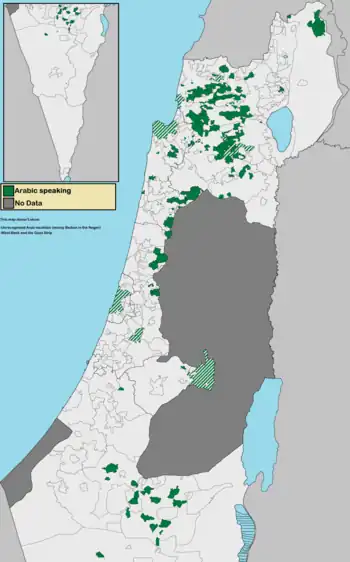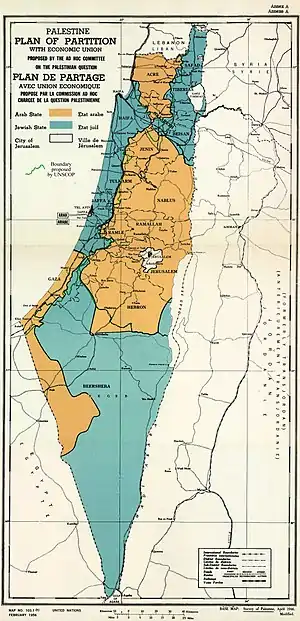
Arab localities in Israel include all population centers with a 50% or higher Arab population in Israel. East Jerusalem and Golan Heights are not internationally recognized parts of Israel proper but have been included in this list.
According to the Israeli Central Bureau of Statistics census in 2010, "the Arab population lives in 134 towns and villages. About 44 percent of them live in towns (compared to 81 percent of the Jewish population); 48 percent live in villages with local councils (compared to 9 percent of the Jewish population). Four percent of the Arab citizens live in small villages with regional councils, while the rest live in unrecognized villages (the proportion is much higher, 31 percent in the Negev)".[1] The Arab population in Israel is located in five main areas: Galilee (54.6% of total Israeli Arabs), Triangle (23.5% of total Israeli Arabs), Golan Heights, East Jerusalem, and Northern Negev (13.5% of total Israeli Arabs).[1] Around 8.4% of Israeli Arabs live in officially mixed Jewish-Arab cities (excluding Arab residents in East Jerusalem), including Haifa, Lod, Ramle, Tel Aviv-Jaffa, Acre, Nof HaGalil, and Ma'alot Tarshiha.[2]
In 2021, there were 163 localities in which all residents are Arab citizens of Israel, 69 of these are Arab local councils and 12 are Arab city councils.[3][4] According to the Israel Democracy Institute about 49.1% of Israeli Arabs live in Arab local councils, 30.9% live in Arab city councils and 8.3% live in officially Mixed cities.[3] Another 5.5% of Arab citizens live in 47 small localities that are incorporated into regional councils, 4.2% live in unrecognized villages (mostly in the Negev), and 1.8% live in cities with Jewish majority (including West Jerusalem).[3] The percentages do not including East Jerusalem Arab residents.[3]
The city of Acre has an Arab minority of 30.1%, while its Old City is 95% Arab. While Arabs constitute 11% of Haifa's total population, they make up 70% of Lower Haifa's residents.[5] In 2011, Jaffa has an Arab population of 30.3%, Lod is 24.3% Arab, while Ramla is 22.2% Arab.[6] In 2015, 23% of the population of Nof HaGalil was Arab.[7]
According to Ha'aretz in 2015, only 16,000 Arabs are thought to be living in 16 localities not officially defined as mixed cities, or in Jewish neighborhoods of Haifa, Jerusalem and Tel Aviv.[8] According to the Israel Central Bureau of Statistics, a sizeable percentage of Arabs lives in the Jewish majority cities of Eilat (5% Arab), Carmiel (4%), Qiryat Shemona (3%), Arad (3%), Beersheva (3%), Nahariyya (2%), Safed (2%) and Tiberias (2%).[9]
Central and Haifa Districts
158,900 Arabs live in the Central District, which has a total population of 1,931,000.[10] 237,200 Arabs live in the Haifa District, which has a total population of 939,000.[10]
The majority of the Arab population in these areas live along or near the Green Line which separates Israel from the West Bank in an area known as the "Triangle", split into the "Northern Triangle" (or Wadi Ara) and the "Southern Triangle".
There is a substantial Druze and Christian population in the Carmel region and the Wadi Nisnas neighborhood of Haifa.[11]
Southern Triangle
Estimated population figures for 2021 are listed below.[12]
- Jaljulia: 10,480
- Kafr Bara: 3,856
- Kafr Qasim: 24,757
- Qalansawe: 23,877
- Tayibe: 45,388
- Tira: 27,392
- Zemer:[lower-alpha 1] 7,360
Northern Triangle
- Ar'ara[lower-alpha 2] 25,823
- Baqa al-Gharbiyye 30,973
- al-Arian 191
- Basma[lower-alpha 3] 10,497
- Jatt 12,473
- Kafr Qara 19,691
- Ma'ale Iron[lower-alpha 4] 15,642
- Meiser 2,084
- Umm al-Fahm 57,677
- Umm al-Qutuf 1,169
Lod
Ramla
Haifa and Carmel region
- Wadi Nisnas, Halisa, Kababir and Abbas (Haifa neighborhoods)†[11]
- Daliyat al-Karmel☆
- Ein Hawd
- Fureidis
- Ibtin
- Isfiya☆†
- Jisr az-Zarqa
- Khawaled
† Significant presence of Christian population
☆ Significant presence of Druze population
Tel Aviv District
18,500 Arabs live in the Tel Aviv District, which has a total population of 1,318,300.[10] 16,000 of them live in Jaffa, where they make up around a third of the population. In 2019 the population of Tel Aviv-Jaffa was 89.9% Jewish, and 4.5% Arabs; among Arabs 82.8% were Muslims, 16.4% were Christians, and 0.8% were Druze.[15]
Jerusalem District
310,700 Arabs live in the Jerusalem District, which has a total population of 987,400.[10] The Arab populations of the Jerusalem District are primarily concentrated in East Jerusalem, which is internationally not considered part of Israel, but there are four other towns that exist within the district's jurisdiction. Abu Ghosh is the largest of them.
West Jerusalem
- Abu Ghosh 7,880
- Beit Jimal
- Ein Naqquba 3,680
- Ein Rafa 1,276
East Jerusalem
East Jerusalem was annexed by Israel after its victory over Jordan during the Six-Day War in 1967. East Jerusalem was joined with West Jerusalem, along with several surrounding Palestinian towns and villages. Today, Arabs constitute 61% of the population of East Jerusalem and 38% of that of Jerusalem as a whole. The following are Arab neighborhoods of Jerusalem.
- Beit Hanina (al-Jadid or Eastern portion)†
- Beit Safafa
- Jabel Mukaber
- Old City (Armenian, Muslim & Christian Quarters)†
- Ras al-Amud
- Sheikh Jarrah
- Shuafat
- Silwan
- Sur Baher
- At-Tur
- Umm Tuba
- Wadi al-Joz
- al-Walaja
† Significant presence of Christian population
Southern District
216,200 Arabs live in the Southern District, which has a total population of 1,146,600.[10] The Arab population lives primarily in the northwestern Negev and is entirely composed of Muslim Bedouins. Several towns in the area are not formally recognized by the government and do not receive basic utilities from the state (see unrecognized Bedouin villages in Israel). The largest Arab locality in the Negev is Rahat.
- Abu Qrenat
- Abu Talul
- Ar'arat an-Naqab
- Ateer
- al-Atrash
- Bir Hadaj
- Dhahiyah
- Drijat
- Ghazzah
- Hura
- Kukhleh
- Kuseife
- Lakiya
- Makhul
- Mitnan
- Mulada
- Qasr al-Sir
- Rahat
- al-Sayyid
- Shaqib al-Salam
- Tirabin al-Sana
- Tel as-Sabi
- Umm Batin
Northern District
705,200 Arabs live in the Northern District, which has a total population of 1,320,800.[10] In 2008, Arabs made up 53% of the Northern District's population, making it Israel's only district with an Arab majority. 44% of the Arab population lives in this district.[16] Nazareth is the largest city, with a population of approximately 66,000.[16]
- Abu Sinan☆†
- Arab al-Aramshe
- Arab al-Subeih
- Arab al-Na'im
- Arraba†
- Basmat Tab'un
- Beit Jann☆
- Bi'ina†
- Bir al-Maksur
- Bu'eine Nujeidat[lower-alpha 5]
- Buqei'a☆†
- Daburiyya
- Ed Dahi
- Deir al-Asad
- Deir Hanna†
- Dmeide
- Eilabun†
- Ein al-Asad☆
- Ein Mahil
- Fassuta†
- Hamaam
- Hamdon
- Hurfeish☆†
- Hussniyya
- I'billin†
- Iksal
- Ilut
- Jadeidi-Makr[lower-alpha 6]
- Jish†
- Julis☆
- Ka'abiyye-Tabbash-Hajajre[lower-alpha 7]
- Kabul
- Kafr Kanna†
- Kafr Manda
- Kafr Misr
- Kafr Yasif†☆
- Kamanneh[lower-alpha 8]
- Kaukab Abu al-Hija
- Kfar Kama[lower-alpha 9]
- Kisra-Sumei☆†[lower-alpha 10]
- Maghar☆†
- Majd al-Krum
- Manshiya Zabda
- Mashhad
- Mazra'a†
- Mi'ilya†
- Muqeible†
- Nahf
- Na'ura
- Nazareth†
- Nein
- Rameh†☆
- Ras al-Ein†
- Rehaniya[lower-alpha 9]
- Reineh†
- Rumana
- Rumat al-Heib
- Sajur☆
- Sakhnin†
- Sallama
- Sandala
- Sha'ab
- Shefa-'Amr†☆
- Sheikh Danun
- Shibli–Umm al-Ghanam[lower-alpha 11]
- Sulam
- Suweid Hamira
- Tarshiha†[lower-alpha 12]
- Tamra City, Akka Subdistrict
- Tamra Village, Jezreel sub-district
- Tuba-Zangariyye[lower-alpha 13]
- Tur'an†
- Uzeir
- Yafa an-Naseriyye†
- Yanuh-Jat☆[lower-alpha 14]
- Yarka☆
- Zarzir
† Significant presence of Christian population († - Christian majority)
☆ Significant presence of Druze population (☆ - Druze majority)
Golan Heights
The Golan Heights was captured during the Six-Day War in 1967 and de facto annexed by Israel in 1981. Israel governs the Golan Heights as a part of the Northern District. As a result of the war, many villages were abandoned. The Israeli Head of Surveying and Demolition Supervision for the Golan Heights proposed the demolition of 127 of the unpopulated villages, with about 90 abandoned villages demolished shortly after 15 May 1968.[17][18] The demolitions were carried out by contractors hired for the job.[18] Five Arab towns remain today. 23,900 Arabs live in the Golan Heights.[10] The area is home to an approximately equal number of non-Arab Israelis.
☆ Significant presence of Druze population (☆ - Druze majority)
† Significant presence of Christian population
See also
Notes
- ↑ The result of a merger of the Arab villages of Yamma, Bir as-Sikka, Ibtan and Marja
- ↑ Result of a merger between Ar'ara and 'Ara
- ↑ Result of a merger between Barta'a, Ein as-Sahala and Mu'awiya
- ↑ Result of the merger of the Arab villages of Bayada, Musmus, Salim, Musheirifa and Zalafa
- ↑ Result of a merger between the town of Bu'eine and the Bedouin village of Nujeidat
- ↑ Result of a merger between the Arab towns of Jadeidi and Makr
- ↑ Result of a merger between Ka'abiyye, Tabash and Hajajre
- ↑ Result of a merger between the Bedouin villages of Kamanneh East and Kamanneh West
- 1 2 Entire population is made of Circassians, but are considered Arabs
- ↑ Result of a merger between Arab villages of Kisra and Kafr Sumei
- ↑ Result of a merger between Bedouin villages of Arab Shibli and Umm al-Ghanam
- ↑ Result of a merger between the Jewish town of Ma'alot and the Arab town of Tarshiha
- ↑ Result of a merger between Bedouin villages of Tuba and az-Zangariyya
- ↑ Result of a merger between Yanuh and Jat
References
- 1 2 "Housing Transformation within Urbanized Communities: The Arab Palestinians in Israel". Geography Research Forum. 27 February 2016. Archived from the original on 3 October 2019.
- ↑ "Topic: Mixed Cities in Israel" (PDF). Inter-Agency Task Force on Israeli Arab Issues. 20 June 2014.
- 1 2 3 4 Haddad Haj-Yahya, Nasreen (2021). "Statistical Report on Arab Society in Israel: 2021". Israel Democracy Institute.
- ↑ "Statistical Report on Arab Society in Israel 2021" (PDF). Israel Democracy Institute: 6-8. 17 March 2021.
- ↑ The Arab Population in Israel. Israel Central Bureau of Statistics. November 2002. p. 3.
- ↑ "opic: Mixed Cities in Israel" (PDF). Inter-Agency Task Force on Israeli Arab Issues. 20 June 2014.
- ↑ Shpigel, Noa (August 22, 2017). "This Israeli mixed Arab-Jewish city is in denial". Haaretz.com. Archived from the original on 2018-12-25. Retrieved 2021-07-15.
- ↑ Sadeh, Shuki (2015-12-25). "A Growing Arab Middle Class Makes a Home in Jewish Cities". Haaretz.com. Retrieved 2022-05-25.: "Some 16,000 Arabs are estimated to be living in 16 cities not officially defined as mixed, or in predominantly Jewish neighborhoods of big cities such as Haifa, Jerusalem and Tel Aviv."
- ↑ Israel Central Bureau of Statistics, "Settlements".
- 1 2 3 4 5 6 7 "Localities and Population, by Population Group, District, Sub-District and Natural Region". Israel Central Bureau of Statistics. 2013. Archived from the original on 13 November 2013. Retrieved 23 December 2013.
- 1 2 Lefkowitz, Daniel (2004). Words and Stones: The Politics of Language and Identity in Israel. Oxford University Press. p. 49. ISBN 9780198028437.
- ↑ "Regional Statistics". Israel Central Bureau of Statistics. Retrieved 22 February 2023.
- ↑ "Topic: Mixed Cities in Israel" (PDF). Inter-Agency Task Force on Israeli Arab Issues. 20 June 2014.
- ↑ "Topic: Mixed Cities in Israel" (PDF). Inter-Agency Task Force on Israeli Arab Issues. 20 June 2014.
- ↑ "Tel Aviv profile: 2019" (PDF). Israel Central Bureau of Statistics. 31 December 2019.
- 1 2 "The Arab Population in Israel 2008" (PDF). Archived from the original (PDF) on 2010-04-01. Retrieved 2010-04-03.
- ↑ Kimmerling, Baruch (2003), Politicide: Ariel Sharon's War Against the Palestinians, Verso, p. 28, ISBN 978-1-84467-532-6
- 1 2 "The Fate of Abandoned Arab Villages, 1965-1969" by Aron Shai (History & Memory - Volume 18, Number 2, Fall/Winter 2006, pp. 86-106)

